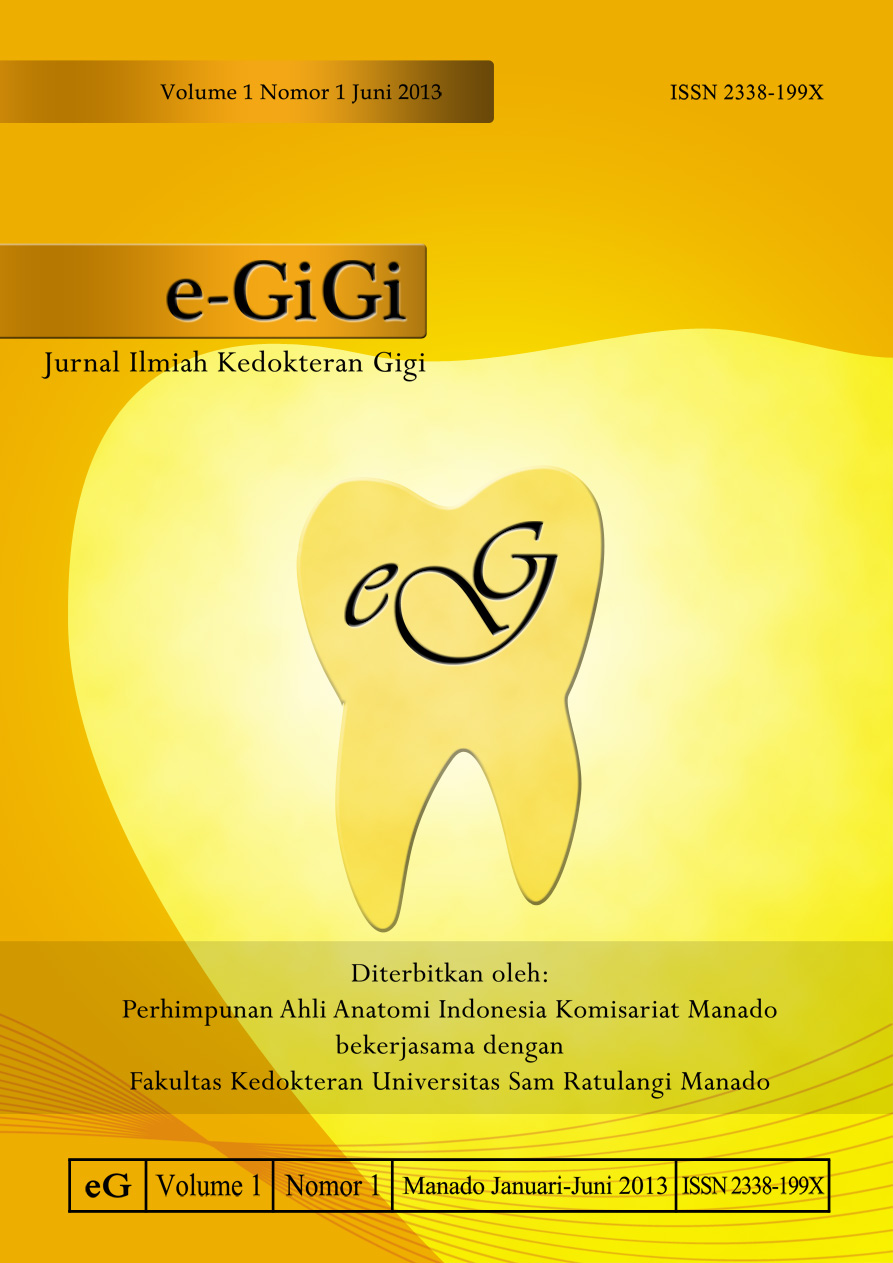GAMBARAN ORAL HABIT PADA MURID SD KATOLIK II St. ANTONIUS PALU
DOI:
https://doi.org/10.35790/eg.1.1.2013.1925Abstract
Abstract: The habit is a repeated pattern of behavior. Habits that occur in the oral cavity is also known as oral habit and naturally occur in less than six years of age. Oral habits might happen to more than six years of age that can lead to abnormalities in the structure of dento-facial. Persistent oral habits may be due to dysfunction and psychological disorders. Attention is needed to prevent oral habit continued. The purpose of this study was to obtain an overview of oral habits at a Catholic Elementary School II St. Anthony Palu students. This type of research used is descriptive study and sampling conducted by the proportional approach of simple random sampling. Data on oral description habit obtained by filling out the questionnaire by the parents / guardians of students. The number of samples in this study are 137 students. The results find that 52 students (38%) had oral habit. Distribution of the types of oral habits shows that four students (7,7%) have thumb sucking habit, 21 students (40,4%) have nail biting habit, 10 students (19,2%) have lip sucking habit, 14 students (27%) have tongue thrusting habit, and 21 students (40,4%) have mouth breathing habit. Boys students have oral habits more than the girl students. An eight-year age group has the most oral habits. Government health agencies in this regard would be able to carry out socialization practices especially regarding oral habits that can affect dento-facial structures.
Key word: Oral habits.
Â
Â
Abstrak: Kebiasaan merupakan suatu pola perilaku yang diulangi. Kebiasaan dapat terjadi didalam rongga mulut yang disebut juga sebagai oral habit dan wajar terjadi pada usia kurang dari enam tahun. Oral habit dapat berlanjut pada usia lebih dari enam tahun yang dapat menyebabkan kelainan pada struktur dento-fasial. Oral habit yang berlanjut tersebut dapat dikarenakan adanya kelainan fungsi tubuh dan gangguan psikologis. Perhatian sangat dibutuhkan untuk mencegah timbulnya oral habit yang berlanjut. Tujuan dari penelitian ini adalah untuk mendapatkan gambaran oral habit pada murid SD Katolik II St. Antonius Palu. Jenis penelitian yang digunakan yaitu penelitian deskriptif dan pengambilan sampel dilakukan dengan metode proportional simple random sampling. Pengambilan data mengenai gambaran oral habit didapat dengan cara pengisian kuesioner oleh orang tua/wali murid. Jumlah sampel dalam penelitian ini sebanyak 137 murid. Hasil penelitian mendapati bahwa 52 murid (38%) memiliki oral habit. Distribusi jenis-jenis oral habit menunjukkan bahwa empat murid (7,7%) murid memiliki kebiasaan menghisap ibu jari, 21 murid (40,4%) memiliki kebiasaan menggigit kuku, 10 murid (19,2%) memiliki kebiasaan menghisap bibir, 14 murid (27%) memiliki kebiasaan mendorong lidah, dan 21 murid (40,4%) memiliki kebiasaan bernafas melalui mulut. Murid-murid yang berjenis kelamin laki-laki memiliki oral habit lebih banyak dibandingkan dengan murid-murid yang berjenis kelamin perempuan. Kelompok usia delapan tahun merupakan yang paling banyak memiliki oral habit. Pemerintah dalam hal ini instansi kesehatan kiranya dapat melaksanakan sosialisasi mengenai kebiasaan-kebiasaan khususnya oral habit yang dapat mempengaruhi struktur dento-fasial.
Kata kunci: oral habit.
Downloads
How to Cite
Issue
Section
License
COPYRIGHT
Authors who publish with this journal agree to the following terms:
Authors hold their copyright and grant this journal the privilege of first publication, with the work simultaneously licensed under a Creative Commons Attribution License that permits others to impart the work with an acknowledgment of the work's origin and initial publication by this journal.
Authors can enter into separate or additional contractual arrangements for the non-exclusive distribution of the journal's published version of the work (for example, post it to an institutional repository or publish it in a book), with an acknowledgment of its underlying publication in this journal.
Authors are permitted and encouraged to post their work online (for example, in institutional repositories or on their website) as it can lead to productive exchanges, as well as earlier and greater citation of the published work (See The Effect of Open Access).






